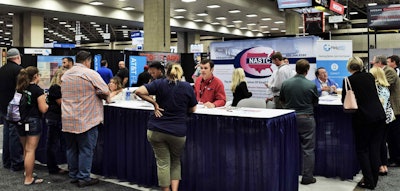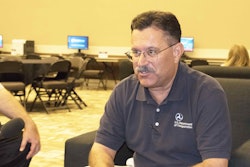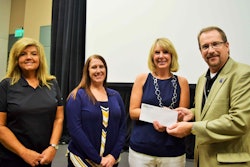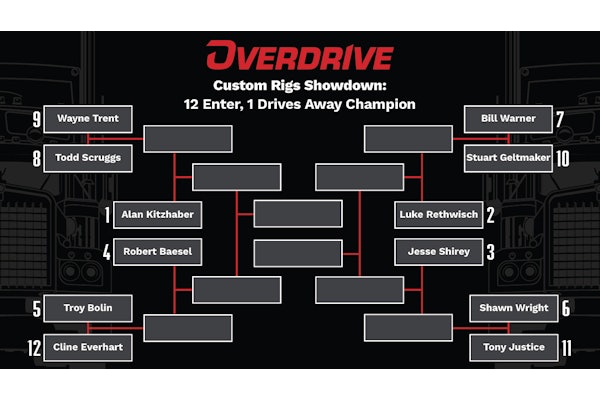 The booth of the National Association of Small Trucking Companies on Day 2 of last week’s Great American Trucking Show was a hub of small-fleet and owner-operator discussion following NASTC’s Day 1 GATS edition of its long-running New Entrant Survival Training seminar for owner-ops and small fleets with new motor carrier authority.
The booth of the National Association of Small Trucking Companies on Day 2 of last week’s Great American Trucking Show was a hub of small-fleet and owner-operator discussion following NASTC’s Day 1 GATS edition of its long-running New Entrant Survival Training seminar for owner-ops and small fleets with new motor carrier authority.National Association of Small Trucking Companies President David Owen says Federal Motor Carrier Safety Administrator Ray Martinez will be the keynote speaker at the NASTC annual meeting in Nashville, set for Thursday-Saturday November 1-3 later this fall. (Find information about the program via this link.)
“He’ll deliver the keynote” at a dinner that Thursday night, Owen notes, then attend the “driver luncheon on Friday” for operators in NASTC’s annual “America’s Best Drivers” awards program for member companies’ haulers. Martinez will also be part of an industry-issues panel Saturday morning to cap off the three-day program.
“We’re going to have some fun,” as usual, at the event, Owen says, which combines a variety of educational and business networking opportunities well-known among NASTC member small fleets and owner-operators, and “Martinez will be right there in the middle of it.”
Owen shared this news with me at GATS, where his organization’s booth was a lively forum for small fleets and owner-ops as show attendance surged over last year’s numbers, in part likely a result of the clearly improved freight economy this past year or so. What’s more, with NASTC’s monthly New Entrant Survival Training (NEST) seminar in its 10th year, the company has put more than 2,000 new owner-operators and small fleet owners through initial paces toward longer-term business success in just the past few years. “We’re averaging about 65 people per class,” says NASTC’s Hunter Owen. Typically held at NASTC headquarters near Nashville, Tenn., the seminar nets attendees a NASTC membership for a year and everything that comes with it for a $250 fee — membership is $300 annually without it, clear evidence NASTC wants the opportunity to get to know and personally interact with its membership with hopes of boosting future trucking success. (Membership comes with access to the well-known NASTC fuel program, delivering volume discounts on fuel at in-network fuel stops among other buying programs that aggregate the group’s size for leverage in contracts on equipment, and much more — a drug-and-alcohol program, other compliance services, trucking software, etc.)

This year’s special edition of the NEST class the first day of GATS in Dallas saw 85 registered attendees, and with “better participation” generally in the NEST class these last several years, Hunter adds, “better results” have followed. The growth spurt in some ways mirrors that in the economy and freight, where in spite of new pressures for so many, like the required turn to ELDs, opportunity in trucking is being taken by around 300 new applicants for motor carrier authority a day of late, according to numbers Hunter’s seen.
NASTC President Owen notes there are “so many different catalysts” for the growth in new authorities, “it’s really hard to know” exactly the reason behind the rise outside of individual cases. But “with the economy doing what it’s doing,” he says, we’re “beginning to make things again” to one degree or another inside the country and clicking along at 4 percent GDP growth. “We definitely have more stuff to haul” in general terms, “and hope it will continue for several years.”
The “biggest problem with this growth spurt is parking,” Owen adds, and the ELD mandate of course did nothing to help that dynamic, a subject for another post coming to a blog near you. At once, Owen finds the focus on hours of service of late to be a bright spot in that otherwise dark dynamic. “If we can get the 30-minute break out, it would alleviate the parking issue at least a little.”
NASTC’s new telemedicine partner
NASTC member companies with 1-2 trucks can newly access HelpMD telemedicine services for as little as $12.50 monthly, useful for a good deal of on-highway maladies that may not really need a visit to a doc’s facility to diagnose and treat. Family access can also be covered in the HelpMD programs, and larger small fleets have access as well, at differing rates.
Tara Golle, HelpMD’s President, was on hand at GATS to answer attendee questions about the service. She notes HelpMD’s hotlines are available 24/7 in all 50 states and those in need can also access services over the HelpMD mobile app. The average wait time for a call-back from a physician with the ability to prescribe medication, she adds, is just 25 minutes.
Those interested might reach out to Skip Williams at NASTC directly — he’s available via [email protected].













